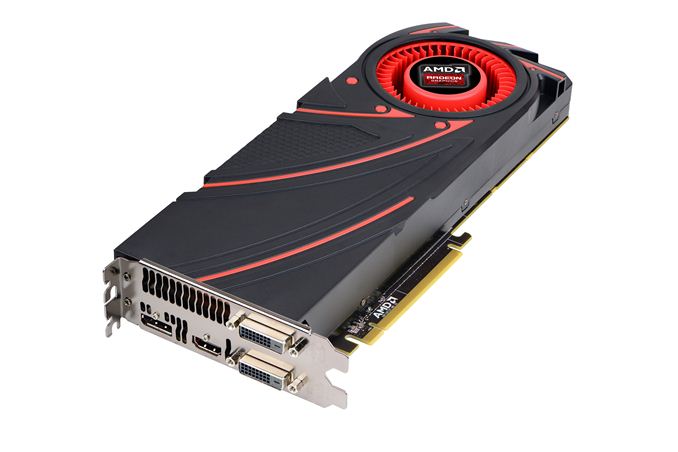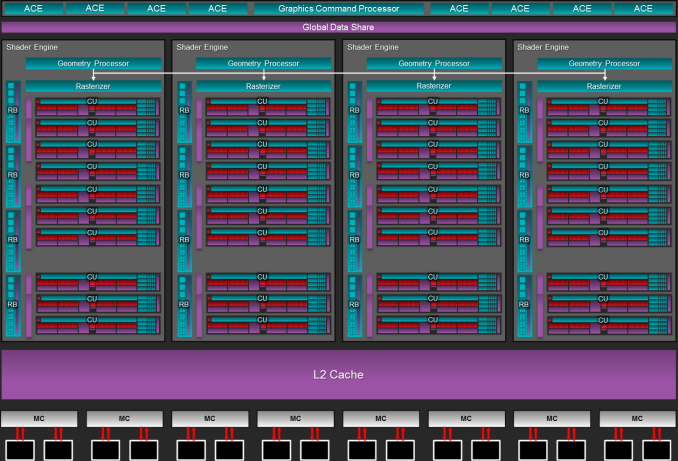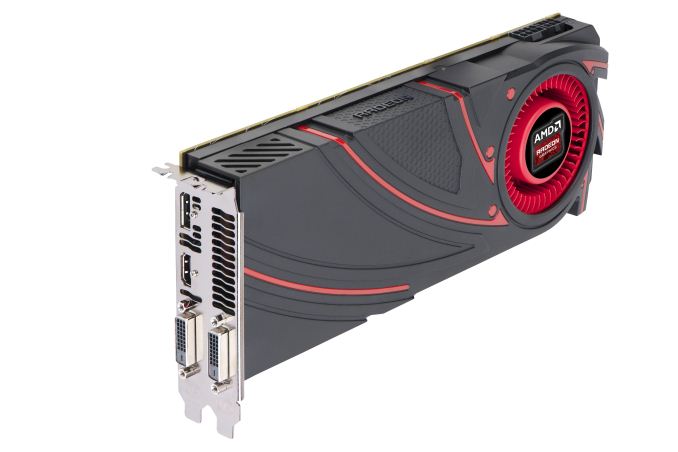The AMD Radeon R9 290 Review
by Ryan Smith on November 5, 2013 12:01 AM EST- Posted in
- GPUs
- AMD
- Radeon
- Hawaii
- Radeon 200

With the launch of AMD’s Radeon R9 290X less than 2 weeks ago, the video card marketplace has become very active very quickly. The 290X not only reasserted AMD’s right to fight for the video card performance crown, but in doing so it has triggered an avalanche of pricing and positioning changes that have affected both NVIDIA and AMD.
NVIDIA for their part cut the price of the GTX 780 and GTX 770 to $500 and $330 respectively, repositioning the cards and giving them their first official price cuts since their spring launches. Meanwhile AMD has also made some changes, and although 290X is unaffected for the moment, 290 was affected before it even launched, receiving an arguably significant specification adjustment. Consequently with GTX 780’s price cut being NVIDIA’s counter to 290X, 290 has gone from just being a lower tier Hawaii card to also being AMD’s counter-counter, and in the process has become a somewhat different card than what it was going to be just one week ago.
But before we get ahead of ourselves, let’s start at the beginning. With the successful launch of the 290X behind them, and the equally successful launch of their new flagship GPU Hawaii, AMD is ready to make their next move. Launching today will be the Radeon R9 290, the obligatory lower-tier part for AMD’s new flagship lineup. Making the usual tradeoffs for a lower-tier part, AMD is cutting down on both the number of functional units and the clockspeeds, the typical methods for die harvesting, in exchange for a lower price. Now officially AMD has not announced the Radeon R9 290 in advance, but with listings for it having already gone up on the same day as the 290X, it’s something that everyone has been expecting.
As always we’ll offer a full breakdown of performance and other attributes in the following pages, but before we even begin with that we want to point out that the 290 is going to be one of AMD’s most controversial and/or hotly debated launches in at least a couple of years. The merits of 290X were already hotly debated in some gaming circles for its noise relative to its performance and competition, and unfortunately 290 is going to be significantly worse in that respect. We’ll have a full rundown in the following pages, but in a nutshell AMD has thrown caution into the wind in the name of maximizing performance.
| AMD GPU Specification Comparison | ||||||
| AMD Radeon R9 290X | AMD Radeon R9 290 | AMD Radeon R9 280X | AMD Radeon HD 7970 | |||
| Stream Processors | 2816 | 2560 | 2048 | 2048 | ||
| Texture Units | 176 | 160 | 128 | 128 | ||
| ROPs | 64 | 64 | 32 | 32 | ||
| Core Clock | 727MHz | 662MHz | 850MHz | 925MHz | ||
| Boost Clock | 1000MHz | 947MHz | 1000MHz | N/A | ||
| Memory Clock | 5GHz GDDR5 | 5GHz GDDR5 | 6GHz GDDR5 | 5.5GHz GDDR5 | ||
| Memory Bus Width | 512-bit | 512-bit | 384-bit | 384-bit | ||
| VRAM | 4GB | 4GB | 3GB | 3GB | ||
| FP64 | 1/8 | 1/8 | 1/4 | 1/4 | ||
| TrueAudio | Y | Y | N | N | ||
| Transistor Count | 6.2B | 6.2B | 4.31B | 4.31B | ||
| Typical Board Power | ~300W (Unofficial) | ~300W (Unofficial) | 250W | 250W | ||
| Manufacturing Process | TSMC 28nm | TSMC 28nm | TSMC 28nm | TSMC 28nm | ||
| Architecture | GCN 1.1 | GCN 1.1 | GCN 1.0 | GCN 1.0 | ||
| GPU | Hawaii | Hawaii | Tahiti | Tahiti | ||
| Launch Date | 10/24/13 | 11/05/13 | 10/11/13 | 12/28/11 | ||
| Launch Price | $549 | $399 | $299 | $549 | ||
Diving right into the hardware specifications, Radeon R9 290 is a bit more powerful than usual for a lower-tier part. AMD has cut the number of CUs from 44 to 40 – disabling 1 CU per SE – while adjusting down the base GPU clockspeed and boost GPU clockspeed to from 727MHz and 1000MHz to 662MHz and 947MHz respectively. However AMD has not cut the amount of memory, the memory clockspeed, the memory bus width, or the number of ROPs, leaving those at 5GHz for the memory clockspeed, 512-bits for the memory bus width, and all 64 ROPs for the back-end hardware.
As a result the differences between the 290 and 290X are on paper limited entirely to the clockspeed differences and the reduced number of CUs. At their top boost bins this gives 290 95% the clockspeed of 290X, and 91% of the shader hardware, giving 290 100% of 290X’s memory performance, 95% of 290X’s ROP and geometry performance, and 86% of 290X’s shading/texturing performance.
Compared to AMD’s last generation offerings, the 290 is going to be closer to 290X than 7950 was to 7970. 290 retains a larger percentage of 290X’s shader and ROP performance, never mind the fact that the full 320GB/sec of memory bandwidth is being retained. As such despite the wider price difference this time around, performance on paper is going to be notably closer. Paper will of course be the key word here, as in the case of 290 more so than any other card we’ve looked at in recent history theory and practice will not line up. Compared to the 290X, practice will be favoring the 290 by far.
Moving on to power consumption, perhaps because of AMD’s more aggressive specifications for their lower-tier card this time around, power consumption is not dropping at all. AMD is still not throwing us any useful hard numbers, but based on our performance data we estimate the 290 to have a nearly identical TDP to the 290X, leading us to keep it at an unofficial 300W. Lower-tier parts typically trade performance for power consumption, but that will not be the case here. Power consumption will be identical while performance will be down, so efficiency will be slipping and 290 will have all the same power/cooling requirements as 290X.
Meanwhile like the 290X launch, the 290 launch is going to be a hard launch, and a full reference launch at that. As such we’ll be seeing 290 cards go up for sale at the usual retailers today, with all of those cards using AMD’s reference cooler and reference board, itself unchanged from the 290X.
As for pricing and competitive positioning, AMD will be launching the 290 at what we consider to be a very aggressive price of $399. Based on the initial specifications, the performance, and the competition, we had been expecting AMD to launch this at $449, mirroring the launch of the 7950 in the process. But AMD has gone one step further by significantly undercutting both themselves and NVIDIA.
290’s immediate competition on the AMD side will be the $549 290X above it and the $299 280X below it, while on the NVIDIA side the competition will be the $499 GTX 780 above it and the $329 GTX 770 below it. Pricing wise this puts 290 as closer competition to 280X/GTX 770 than it does the high-tier cards, but as we’ll see in our benchmarks AMD is aiming for the top with regards to performance, which will make price/performance comparisons both interesting and frustrating at the same time.
NVIDIA for their part will have their 3 game Holiday GeForce Bundle on the GTX 780 and GTX 770, presenting the same wildcard factor for overall value that we saw with the 290X launch. As always, the value of bundles are ultimately up to the buyer, especially in this case since we’re looking at a rather significant $100 price gap between the 290 and the GTX 780.
| Fall 2013 GPU Pricing Comparison | |||||
| AMD | Price | NVIDIA | |||
| Radeon R9 290X | $550 | ||||
| $500 | GeForce GTX 780 | ||||
| Radeon R9 290 | $400 | ||||
| $330 | GeForce GTX 770 | ||||
| Radeon R9 280X | $300 | ||||
| $250 | GeForce GTX 760 | ||||
| Radeon R9 270X | $200 | ||||
| $180 | GeForce GTX 660 | ||||
| $150 | GeForce GTX 650 Ti Boost | ||||
| Radeon R7 260X | $140 | ||||












295 Comments
View All Comments
DMCalloway - Wednesday, November 6, 2013 - link
Not sure how to interpret your analogy. Heat is measured in watts (energy) needing dissipation. This card is running up to 95*C while drawing around 50 more watts of power than a 780 . The 780 while drawing 50 less watts of power is running up to 80*C. Out of the gate the heat sink on the R290 is going to have to be at LEAST 20% more effective than the current 780 heat sink, and this thermal excess is still being pumped into the case.Galidou - Friday, November 15, 2013 - link
Well as I can see you are rather unfamiliar with power leakage due to temperature... anyway I won't get into the subject, I'll let you google it. Getting a card to run a lot cooler at the same frequencies can reduces power usage depending on how bad it affects certain node.A 20 degree celsius difference can have a great impact on power usage which I think might turn the tide around. In 28nm design, power leakage has been a bigger problem than before, probably a reason why Nvidia has been using better reference coolers thus, enhancing the performance/watt for the last generations of video cards.
That is the basis of my previous analogy.
TrantaLocked - Tuesday, November 5, 2013 - link
With the card in the case, with headphones on, with sounds/music from the game playing, hearing the 290 or any card would be tough. I know what loud video cards sound like (I owned the 4890 with a single fan design, and I always ran the fan at manual 40%-50% speed for gaming), and when playing a game with headphones the sound is barely audible and definitely not distracting.Calinou__ - Tuesday, November 5, 2013 - link
I have a reference 570 in a sound dampened case and a headset and I can easily hear it, even at idle (40% fan speed)... and I guess the R9 290 is more noisy.Galidou - Tuesday, November 5, 2013 - link
A reference 570 if not cleaned regularly(once every two months) goes easily up to 62 db. GTX 480 went up to 64 db(brand new) and Nvidia fans praised it even if AMD fans were saying it was loud, nothing new in here... Nvidia fans once said that 64 db is ''nothing'' for a good performing card... Look at them now speaking and whining about the same situation, really fun to see the tides turn around...That was in a time when reference coolers where much more used and represented a MUCH bigger % of the market, I would never buy an AMD reference cooled card. Nvidia fans started to care about noise and temperature when they got the 600 series out and for the first time had an advantage.
Finally - Tuesday, November 5, 2013 - link
Whoever buys a card with the default fan? Get one with a custom design and problem solved. How hard is that?Aikouka - Tuesday, November 5, 2013 - link
Anyone that buys it right now? =Pkmmatney - Tuesday, November 5, 2013 - link
I used to think that too, until I actually bought a loud HD4890. I ended up having to get an Accelero, which made it dead quiet. My current NVidia based card is also really loud, but I fixed that buy underclocking it most of the time. Really loud cards are just not fun to deal with. I'd wait for third party cards to come out with better cooling solutions.hoboville - Tuesday, November 5, 2013 - link
Except that it's hot, noisy, and basically pointless to overclock because it's as loud as a medium party without music. So as it is, it's a bad card.However, since it's only $400, one could go out and buy a water cooling setup and have a card faster than the 290x for about the same or less money. For Titan money, you could get a second 290 and add some more rads to your setup. The thing is...if you do want to OC (and why wouldn't you with water cooling?), you'll have to dissipate over 800 watts of heat...
Slomo4shO - Tuesday, November 5, 2013 - link
Well done AMD. Competition at its finest!